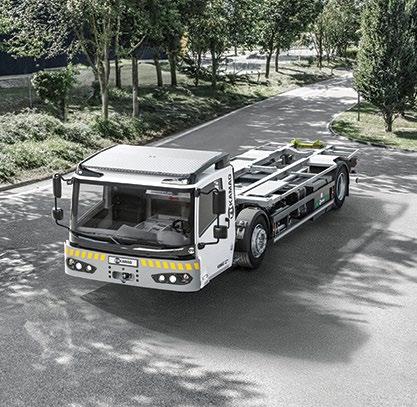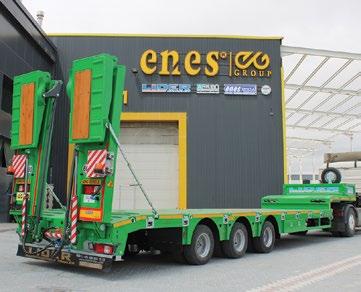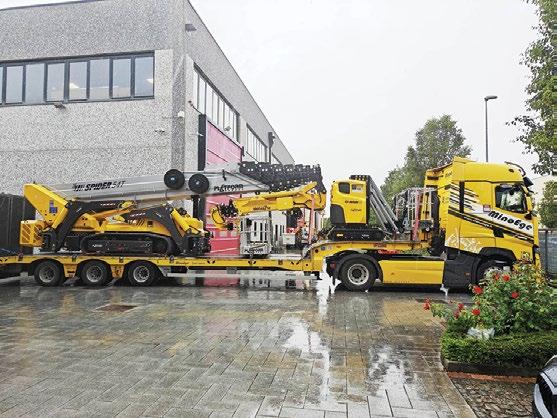
13 minute read
Trailers for sale or rent
Trailers for sale or rent
Transporting equipment and components to and from its point of use safely and efficiently is a major factor in the rental business. Over recent years trailers have evolved to cater for heavy or bulkier loads, or tailored to suit specific applications, such as delivering aerial work platforms, in the most efficient manner. We take a look at what to look for in a trailer as well as reviewing several new products.
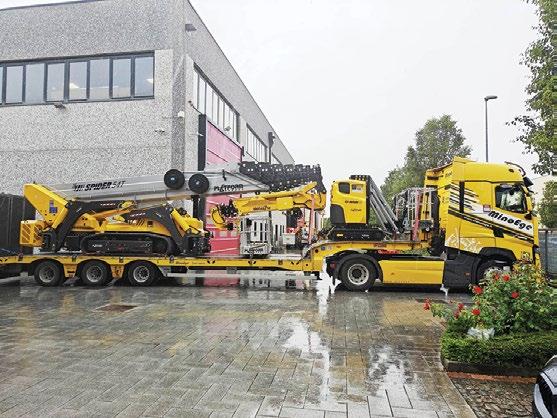
Trailers come in all shapes and sizes from the smallest single axle equipment trailer to the monster 40 or more axle specialist girder frame trailers and everything in between. But whatever the size, a trailer has to do the job you need it to do. Not all trailers are created equal, and that is usually intentional. For example, a trailer aimed at transporting slab electric scissors will often be different to one carrying telehandlers. Essential questions to ask include:
• What items need carrying - general rental equipment, aerial lifts, accommodation units etc
• What ground clearance does the equipment have
• What size are the items, are there desirable break points - such as two 60ft booms etc.. or a 2,900kg spider lift.
• What sort of product mix makes a typical or ideal load? - eg two slab scissors and a boom?
• What sort of ground bearing point loads do the machines apply
• What type of site or drop off point is typical
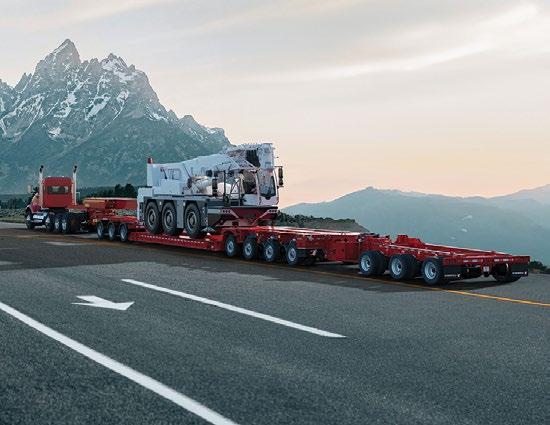
“A trailer is never just a trailer,” says Troy Geisler, vice president of sales and marketing of Talbert Manufacturing based in Indiana, USA. “It can be manufactured to many different specifications, but the end result should always be an ideal trailer for an operation’s specific loads.
To select a trailer that will require the least amount of maintenance, provide the greatest lifespan and deliver the highest possible return on investment, it is vital to understand the trailer’s true capacity.”

Talbert has been building heavy haulage and specialised trailers since 1938. The company offers a wide range for the commercial, industrial, military and government sectors used in applications including renewable energy, aerospace, heavy construction, in-plant material handling, manufacturing and processing systems.
According to Geisler there are five contributors to capacity ratings, and each can be varied to meet a carrier’s specifications. Operators should consider load concentration, load distribution, speed, safety and materials.
“There are no industry standards when it comes to determining capacity ratings. To ensure maximum utilisation, operators need to pay special attention to load concentration, or the length of the deck that can handle the rated weight. Obviously, a 50 ton lowbed can haul 50 tons. But how much of the deck those 50 tons occupy is just as important as the weight itself. While one trailer might need the entire 26 feet/8m to be rated at 50 tons, another can handle that same weight in half the deck length. Since loads are rarely 26 feet long, these ratings give a more realistic indication of the concentrated loads the trailer will be able to handle safely and without structural failure.”

How a load is distributed over the deck and the number of required axles is also an important consideration when selecting the right trailer. “In the US, axle weight laws and regulations vary from state to state, so fleet managers and operators need to work with manufacturers to define the best trailer for the cargo and the bestaxle configurations to maximise the load in their area of operation.”

“There are many options for achieving the best possible weight distribution over the axles, depending on the local regulations and the nature of the load. For example, carriers can vary gooseneck lengths in the front, alter the distances between axles and axle groups, move the load closer to one end or the other, or use a jeep dolly to add extra axles. However, these options must be included in the initial trailer design - simply adding them afterward risks the structural integrity of the trailer and the safety of operators and the public.”
Speed and Safety
“Another capacity determinant is speed. While some manufacturers rate their trailers at 55 mph, others rate them at 65 mph. The slower a rig travels the less added weight or stress is placed on the trailer. This is because, while road dynamics such as potholes, railroad tracks and so on still have an effect, the impact on the trailer decreases along with the speed.”
A trailer’s safety rating also comes into play when discussing capacity. A safety rating is an indicator of how much stress a trailer can safely handle. It encompasses factors such as the strength of the raw materials used in the trailer’s construction and how the beams and cross members are configured.
“The widely accepted average magnification of payload weight on a trailer due to road dynamics is a 1.8:1 ratio. However, on any given haul, stress on the trailer can go above that level multiple times. If no cushion is built in to handle those spikes in stress, there is potential for long term, progressive structural damage. That is why some manufacturers use a ratio of 2.5 to 1, which is considered an ample cushion for even the most extreme road dynamics a trailer might encounter.”
Not only does the safety rating tell an owner how strong their trailer is, but it’s also a very good indicator of potential life. Typically, the greater the difference between the static design safety factor and the dynamic 1.8 average multiplier, the longer a trailer’s useful life expectancy.
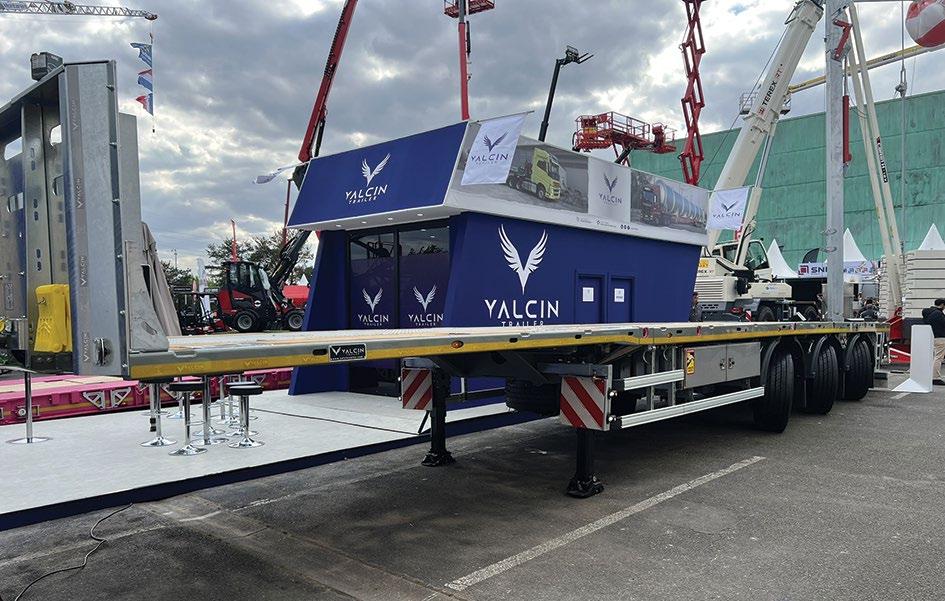
Materials
Safety factors are strongly related to the quality of the components incorporated into the trailer, such as the steel and deck material.
“There are several options when choosing steel, but for the most capacity and smallest impact on the trailer weight, reputable manufacturers use a T1 material which offers maximum strength versus ductility and equates to a lighter, stronger trailer frame. A trailer’s decking is continually exposed to the elements, making durable decking with a long wear life crucial. Tightly woven and incredibly dense, apitong decking provides a tougher, longer lasting wood in comparison to other varieties such as oak or pine. It’s also less susceptible to chipping and cracking and provides some traction in comparison to a smooth metal surface.”
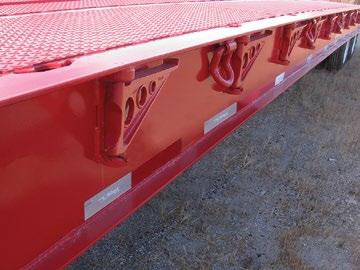
Specialist UK manufacturer Sterling GP has almost 30 years’ experience in this sector, producing its first truck body for transporting construction related equipment - a 7.5 tonne beavertail - in 1996.

Payload
The total unladen truck will weigh13,255kg, leaving up to 18,745kg available for the load - i.e. its payload. Payload will vary from truck to truck but typically most beavertails can expect to achieve 18.5 tonnes on a 32 tonner, 14 tonnes on a 26 tonner and 9.5 tonnes on an 18 tonner. These figures are for trucks with equipment bodies only. If a loader crane is fitted, this will of course, reduce the available payload.
As with any capital expenditure, the initial purchase price of a trailer or truck body is only half of the equation. When comparing quotations consider the specification, even when they appear equal - same dimensions, same ramp styles, same quantity of lashing points - as well as other factors not necessarily detailed in the spec, such as build quality and aftersales care?
A beavertail truck body has moving parts and experiences strains unlike other bodies so it’s important to ensure reliability and longevity. When there is a breakdown, remember that it is not just the cost of the body repair but the downtime and the cost of letting customers down.
Also, how much is the selected body going to affect the residual value of the vehicle? Whilst this is always an unknown until the vehicle is sold, it’s a safe bet that a truck body in better condition will attract more interest and command a higher price, reducing overall cost of ownership and providing a better return on investment.

Work at Height protection
Increasingly stringent Work at Height legislation and policing has resulted in trailer and truck body manufacturers offering various products to ensure the safety of those working on the trailers or trucks.
Whilst edge protection/fall arrest is not always stipulated by law, many companies choose to specify it. Fall restraint systems running along the sides of the body/bed come in different variations with the most common being Post & Socket or Fold-out.
The simplest system, Post & Socket is exactly as described. Whilst it limits working space to within the deck width, it is simply removed and stowed when loading over-width machines. Fold-out systems usually come with a walkway supplied which provides additional width and enables operators to walk beside wide machines on the truck/trailer. However, the system is more complex to remove when transporting over width machines. Regardless of which system is chosen, they must be coupled with safe access, usually by an access ladder situated on the side of the vehicle. Locating the ladder near the headboard means a grab handle can be fitted to the headboard providing the necessary three points of contact.
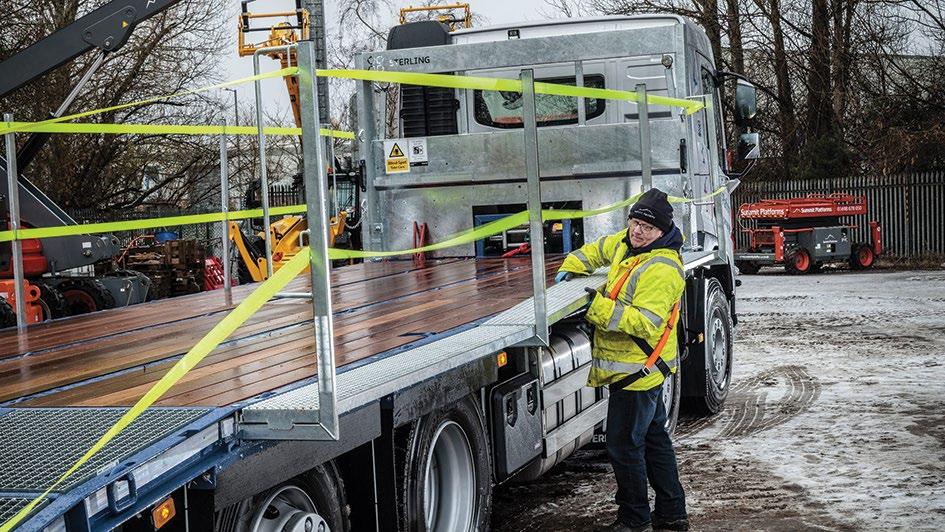
Sufficient lighting is also crucial to aiding safe loading and minimising falls from height risks, particularly when working at night and/ or in low light areas such as tunnels. LED work lights mounted high on the headboard or back of the cab can provide the necessary illumination.
Providing the correct decking material can also minimise risks. Mesh decking and nonslip surface options provide improved grip - particularly in wet conditions - which can prevent falls caused by slipping.
When carrying smaller items of equipment on beavertail trucks for example, some machines such as slap electric scissor lifts with their small smooth wheels have very little grip which can easily spin or slide on a loading ramp. As a result, most body manufacturers offer alternatives to traditional hardwood timber decking. However, some of these alternatives are unsuitable and can pose a risk to the loading operator. It is also good practice to use a bed mounted winch with remote control when loading - although it will reduce payload of course.
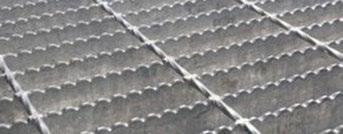
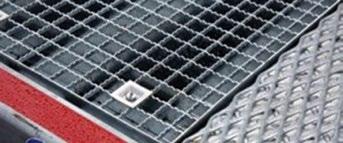
Most powered access companies using a Sterling access body fitted with the common serrated steel deck grating have said that whilst offering improved grip in the dry it can become extremely slippery when wet making loading more difficult and at times dangerous. The reason for this is that the serrated grating is a ‘wavy’ style which is very smooth so when wet offers much reduced friction. Sterling’s solution is a dual serrated mesh. The serration runs in both directions providing lateral grip and is now the recommended option on ‘access specification’ bodies.
New Rhino Access Trailer
One new trailer designed specifically for single aerial lifts or sub compact telehandlers, is the two axle Rhino Access Platform Trailer from Towmate Trailers in the UK. Designed in-house it has a 2,995kg payload resulting in a total weight of less than 3.5 tonnes, so towable behind a pick-up or 4x4 car.
The Rhino has a pair of lightweight, 2.4 metre long aluminium ramps which provide a shallow gradient for loading. The ramps are stowed using built in storage pockets on the side of the trailer. The trailer also has Towmate’s aluminium grip deck rails which offer a lightweight, stable base for the machine to be transported on. These eliminate the issues of rotting timber floors by allowing any dirt or water to fall through the gaps in the deck rather than the water collecting on the surface. The company says this also provides a great platform to pressure wash machines without having to unload them.
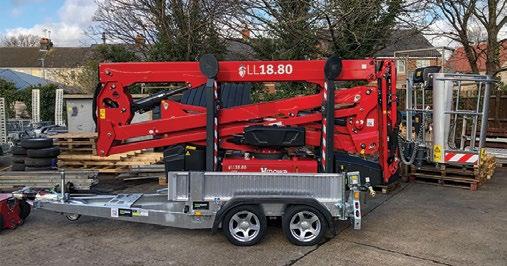
The trailer comes with a 480mm serrated jockey wheel to help when manoeuvring the trailer, and 480mm serrated prop stands at the rear to support the trailer during loading. LED dual voltage lights - reliable and more resistant to vibrationsare fitted along with the heavy duty running gear. Optional upgrades include a flooring infill panel in either plywood or GRP mini mesh material, a galvanised storage box to the trailer, and a spare wheel and carrier if needed.
Faymonville Streetmax
Recently launched in North America, the Faymonville nine-axle StreetMAX double-drop trailer aims to provide more payload and greater manoeuvrability for transporting high or heavy loads. The double drop configuration helps in states where there are strict axle load and height restrictions or when the planned route is particularly winding.
The unit features a hydraulically liftable and detachable gooseneck which allows continuous height adjustment and improving safety during loading and unloading. Enhanced manoeuvrability is achieved using pendle axle technology with a stroke of more than 600mm. The nine axle trailer is king pin steered with a steering angle up to 60 degrees. Depending on the load that has to be transported, the operator can change between a flat deck, perimeter deck or spine deck. With the possibility to add a three axle jeep dolly under the gooseneck, this front part is able to support at least 100,000lb/45.4 tonnes. At the rear, a three axle bogie can be coupled with a three axle booster so that the payload and the manoeuvrability increase due to those extra turning points. If additional payload is needed, a steerable single axle can be added between the low bed and the rear bogie - a ‘Joker axle’. The frame is fully galvanized.
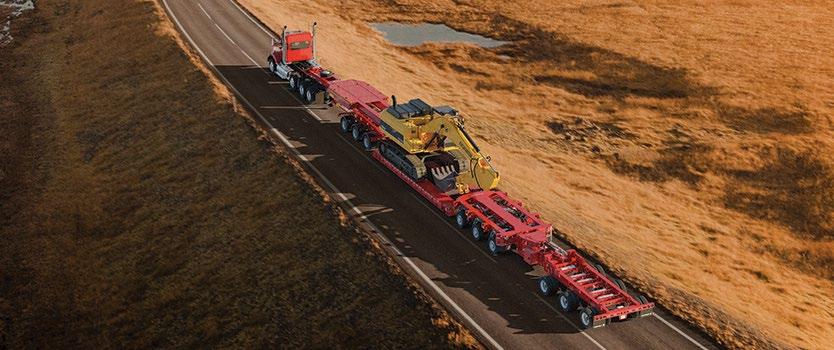

The new Kamag Eprecisionmover
German manufacturer TII Kamag - which includes Scheuerle, Nicolas and TII India - has launched the third generation of the fully electric powered swap body transporter. The ePrecisionMover (ePM) enables emission free handling of swap bodies and trailers for yard logistic operations.
The ePM allows the quick and safe handling of swap bodies of all conventional sizes as well as semi-trailers without any reduction in functionality compared to diesel drive systems. The electric drive ensures quiet and emission-free operation. The third generation vehicle offers shorter charging times and higher energy efficiency. Equipped with four Webasto batteries with a total capacity of 140 kWh, the ePM can be operated continuously for up to nine hours depending on the operating conditions. A complete recharge is possible in only 90 minutes. With a consumption of 12kW per operating hour, the ePM can recharge its batteries in just 25 minutes after 3.5 hours of use
The Kamag PrecisionMover (PM), also known as the Wiesel, has become a bestseller since its introduction in 1995, with more than 2,500 in use in more than 20 European countries. Approval for road use is also available which allows the PM to transport swap bodies on public roads. ■
